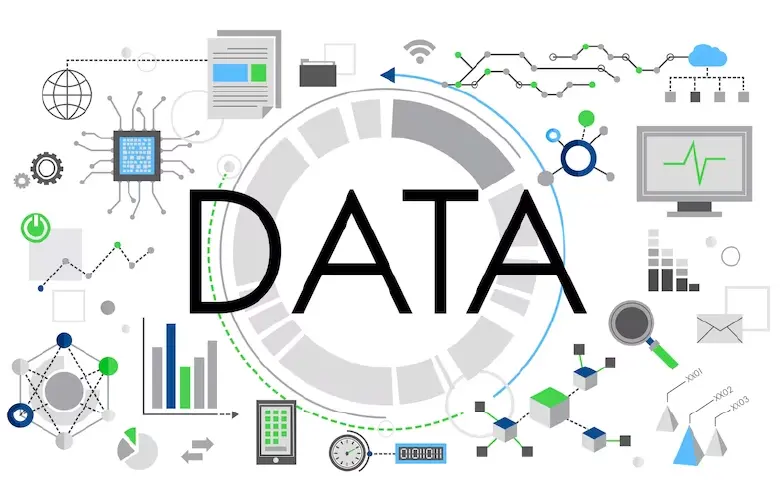Data has become the lifeblood of the modern world, driving innovation, decision-making, and business strategies across various industries. From the moment we wake up to the countless interactions throughout the day, we generate and interact with data in various forms. This comprehensive guide will delve into everything you need to know about data, from its types and sources to its processing, analysis, and ethical considerations.
Introduction to Data
What is data?
Data refers to raw facts, figures, and statistics collected or generated by individuals, organizations, machines, or systems. It can be in the form of text, numbers, images, videos, or any other format that computers can process.
Importance of data in the modern world
In today’s digital age, data drives decision-making, enables innovation, and fuels economic growth. It empowers businesses to understand customer behaviour, optimize processes, and gain competitive advantages in the market.
Types of Data
Data can be classified into three main types:
Structured data
Structured data is highly organized and follows a predefined format. It is typically stored in databases and can be easily queried and analyzed using SQL or other database management tools.
Unstructured data
Unstructured data lacks a predefined data model or organization. It includes text documents, emails, social media posts, and multimedia files. Analyzing unstructured data requires advanced techniques such as natural language processing (NLP) and sentiment analysis.
Semi-structured data
Semi-structured data falls somewhere between structured and unstructured data. It contains tags, markers, or other organizational elements that provide some structure but do not fit neatly into a relational database.
Sources of Data
Data can be sourced from various channels, including:
Online sources
Online platforms such as websites, social media, and mobile apps generate vast amounts of data through user interactions, clicks, searches, and transactions.
Offline sources
Offline sources include physical documents, records, and archives maintained by organizations, government agencies, and institutions.
Sensor-generated data
Sensors embedded in devices, machines, and IoT (Internet of Things) devices generate real-time data about environmental conditions, equipment performance, and user interactions.
Data Collection Methods
Collecting data involves various methods and techniques, including:
Surveys and questionnaires
Surveys and questionnaires are structured data collection tools used to gather information from individuals or groups through standardized questions.
Interviews
Interviews involve direct interaction with respondents to collect qualitative data, insights, and opinions on specific topics or issues.
Observational studies
Observational studies involve systematically observing and recording behaviours, events, or phenomena in natural settings to gather data.
Web scraping
Web scraping is the process of extracting data from websites using automated tools or scripts. It enables organizations to collect data from multiple sources for analysis.
Sensors and IoT devices
Sensors and IoT devices collect real-time data about physical objects, environments, and processes, providing valuable insights for decision making and optimization.
Data Processing and Analysis
Once data is collected, it undergoes processing and analysis to derive meaningful insights and actionable intelligence. This involves:
Cleaning and preprocessing
Data cleaning involves identifying and correcting errors, inconsistencies, and missing values in the dataset. Preprocessing prepares the data for analysis by transforming, standardizing, and normalizing it.
Exploratory data analysis (EDA)
EDA involves visualizing and summarizing the main characteristics of the dataset to identify patterns, trends, and relationships. It helps analysts understand the underlying structure of the data and generate hypotheses for further investigation.
Statistical analysis
Statistical analysis involves applying mathematical and statistical techniques to analyze data, test hypotheses, and make inferences about populations based on sample data.
Machine learning and predictive modelling
Machine learning algorithms analyze data to identify patterns, make predictions, and automate decision making. Predictive modelling uses historical data to forecast future outcomes and trends.
Data Storage
Storing data securely and efficiently is essential for data management and accessibility. Common storage solutions include:
Databases
Databases are structured repositories that store and manage data in a tabular format, allowing for efficient retrieval, manipulation, and querying.
Data warehouses
Data warehouses are centralized repositories that consolidate data from multiple sources for analysis and reporting. They are optimized for querying and analyzing large volumes of data.
Data lakes
Data lakes are scalable repositories that store raw, unstructured, and semi-structured data in its native format. They enable organizations to store vast amounts of data for future analysis and exploration.
Data Visualization
Data visualization is the graphical representation of data to communicate information effectively. It includes:
Importance of data visualization
Data visualization helps analysts and decision makers understand complex datasets, identify trends and patterns, and communicate insights visually.
Types of data visualization tools
There are various data visualization tools available, including charts, graphs, maps, and dashboards, that enable users to create interactive and informative visualizations.
Best practices for effective data visualization
Effective data visualization requires clear design principles, including choosing the right visualization type, labeling axes, using appropriate colours, and providing contextual information.
Data Security and Privacy
Protecting data from unauthorized access, manipulation, and theft is paramount. This involves:
Importance of data security
Data security ensures the confidentiality, integrity, and availability of data, safeguarding it from cyber threats, breaches, and malicious attacks.
Common data security threats
Data security threats include hacking, malware, phishing, insider threats, and social engineering attacks that exploit vulnerabilities in systems and networks.
Strategies for data protection and privacy
Implementing encryption, access controls, authentication mechanisms, and security protocols helps mitigate data security risks and protect sensitive information from unauthorized disclosure.
Data Governance
Data governance refers to the framework, policies, and processes for managing and controlling data assets within an organization. It includes:
Definition of data governance
Data governance establishes roles, responsibilities, and accountability for data management, ensuring compliance with regulatory requirements and organizational standards.
Components of effective data governance
Effective data governance involves establishing data policies, standards, quality measures, and stewardship practices to ensure data integrity, consistency, and reliability.
Benefits of implementing data governance
Data governance enhances data quality, transparency, and trustworthiness, enabling organizations to make informed decisions and derive maximum value from their data assets.
Data Ethics
Ethical considerations are paramount in the collection, analysis, and use of data. This involves:
Ethical considerations in data collection and analysis
Ethical data practices involve obtaining informed consent, protecting privacy, ensuring data anonymity, and minimizing bias in data collection and analysis.
Guidelines for Ethical Data Use
Ethical guidelines provide principles and standards for responsible data use, including transparency, fairness, accountability, and respect for individuals’ rights and freedoms.
Examples of ethical dilemmas in data science
Ethical dilemmas in data science include issues related to privacy violations, algorithmic bias, discrimination, and unintended consequences of data-driven decisions.
Data Monetization
Data monetization refers to the process of generating revenue from data assets. This involves:
What is data monetization?
Data monetization involves extracting value from data through various means, including selling data, licensing data, offering data-based services, and monetizing data insights.
Strategies for monetizing data
Monetizing data requires identifying valuable data assets, understanding market demand, and leveraging data analytics and technology platforms to create value for customers and stakeholders.
Case studies of successful data monetization efforts
Successful data monetization efforts include companies leveraging customer data for targeted advertising, subscription-based services, and personalized recommendations, resulting in increased revenue and market share.
Future Trends in Data
The future of data is driven by technological advancements, innovation, and emerging trends, including:
Artificial intelligence and machine learning advancements
Advancements in AI and ML technologies enable automated data analysis, predictive modeling, and decision making, transforming industries and business processes.
Big data analytics
Big data analytics enables organizations to harness large volumes of data from diverse sources to gain insights, drive innovation, and create value for customers and stakeholders.
The rise of edge computing
Edge computing brings data processing and analytics closer to the source of data generation, enabling real-time insights, reduced latency, and improved performance for IoT and mobile applications.
Challenges in Dealing with Data
Despite its benefits, dealing with data poses various challenges, including:
Data quality issues
Data quality issues, such as inaccuracies, incompleteness, and inconsistency, can undermine the validity and reliability of data analysis and decision-making.
Data silos
Data silos occur when data is stored and managed in isolated systems or departments, hindering data sharing, collaboration, and integration across the organization.
Regulatory compliance
Regulatory compliance requirements, such as GDPR, HIPAA, and CCPA, impose strict rules and obligations on organizations regarding data privacy, security, and governance.
Role of Data in Various Industries
Data plays a crucial role in various industries, including:
Healthcare
In healthcare, data-driven insights improve patient care, optimize treatment plans, and enhance operational efficiency, leading to better health outcomes and reduced costs.
Finance
In finance, data analytics enables risk management, fraud detection, algorithmic trading, and personalized financial services, driving innovation and competitiveness in the industry.
Retail
In retail, data analytics powers customer segmentation, inventory management, demand forecasting, and personalized marketing strategies, enhancing customer experiences and driving sales growth.
Marketing
In marketing, data-driven insights enable targeted advertising, customer segmentation, campaign optimization, and performance tracking, maximizing return on investment and driving business growth.
Conclusion
Data is the foundation of the digital economy, empowering organizations to make informed decisions, drive innovation, and create value for customers and stakeholders. By understanding the types, sources, processing methods, and ethical considerations of data, businesses can harness its power to gain competitive advantages and drive sustainable growth in the modern world.
Unique FAQs
- How is data different from information?
- Data refers to raw facts and figures, while information is processed and organized data that provides context, meaning, and relevance.
- What are the main challenges in data governance?
- The main challenges in data governance include ensuring data quality, enforcing compliance, managing data privacy, and overcoming organizational resistance to change.
- What role does data visualization play in data analysis?
- Data visualization helps analysts explore patterns, trends, and relationships in data, communicate insights effectively, and facilitate decision-making by presenting complex information in a visual format.
- How can businesses monetize their data assets?
- Businesses can monetize their data assets by selling data to third parties, licensing data for commercial use, offering data-based services or products, and leveraging data insights to improve operations and customer experiences.
- What are the ethical implications of data collection and analysis?
- Ethical implications of data collection and analysis include privacy violations, data misuse, bias in algorithms, discrimination, and unintended consequences of data-driven decisions.


